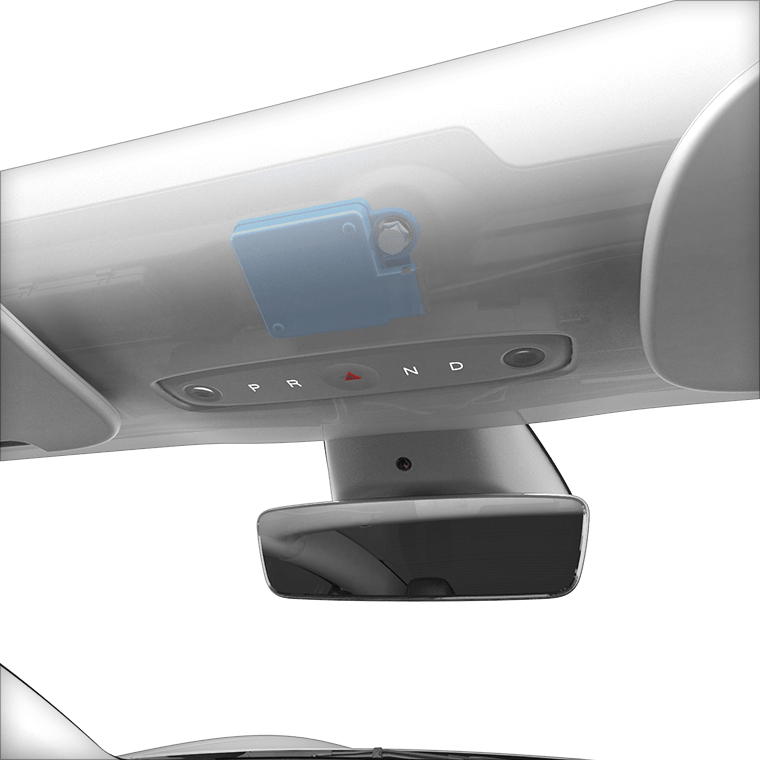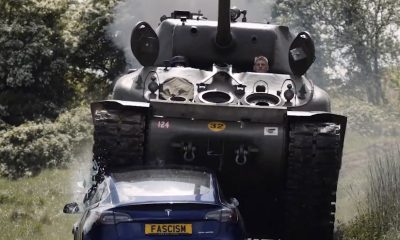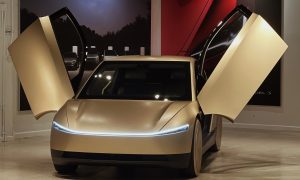Tesla has officially started deploying a software update activating its in-cabin radar, a feature that has been supported and expected for a few years, and one that may require a retrofit for some owners.
On Friday, Tesla began rolling out software update 2025.2.6, featuring the activation of its in-cabin radar located just above the passenger dome light. The company lists the feature in its owner’s manuals, noting that the cabin radar is currently only available for 2022 model-year Model Y units and later, though it’s also expected to roll out to refreshed Model 3 and Cybertruck units at some point.
Some have also said that they believe the refreshed Model S and Model X have been equipped with the radar hardware, so it’s possible these vehicles could also receive the feature. Tesla calls the feature the First-Row Cabin Sensing Update in the release notes for 2025.2.6, which also seems to be related to the company’s debut of the so-called 4D Radar in the new Model Y.
What does Tesla’s in-cabin radar do?
“Cabin radar can detect the presence of people inside the vehicle and use the measurements to determine occupancy,” Tesla writes in the owner’s manual. “Cabin radar supports certain vehicle and safety features, such as occupancy detection for the front passenger seat.”
The benefit of cabin radar is that it uses radio waves to detect objects and passengers inside the vehicle, and it can do so more precisely than the selfie camera when identifying what exactly is in the front and rear seats. Recently, Tesla has also highlighted the 4D radar system’s ability to pick up on things like the heartbeat of a pet or small child, offering an extra layer of safety for passengers.
READ MORE ON IN-CABIN RADAR: Tesla plans to use cabin radar, ditching seat sensors for safety
In a video interview with Tesla Owners Silicon Valley earlier this week, the company’s Model Y Program Manager, Emmanuel Lamacchia, also detailed the 4D imaging radar, saying that it both detects and classifies passengers based on their size. This lets the system toggle necessary airbags and even take further precautions against passengers being left behind in the vehicle.
Eventually, Lamacchia says the system will be able to protect against a child or pet being left behind by sending a reminder to owners, turning on the HVAC system, rolling down the window, or even calling 911. The Model Y Program Manager says that these will be enabled in the refreshed model in Q3.
Tesla’s Lead Cybertruck Engineer said on X on Friday that, while incidents related to these issues are extremely low, their severity can be extremely high, pointing to the importance of the upcoming feature.
You can watch the full talk from Lamacchia and Tesla Owners Silicon Valley below, with the bit about the 4D in-cabin radar starting around 30:30.
What are your thoughts? Let me know at [email protected], find me on X at @zacharyvisconti, or send us tips at [email protected].
Tesla vehicles in the U.S. are set to get this long-awaited feature
Need accessories for your Tesla? Check out the Teslarati Marketplace:
Elon Musk
Tesla seems to have fixed one of Full Self-Driving’s most annoying features
Tesla seems to have resolved an issue that many users of the Full Self-Driving suite complained about recently.

Tesla seems to have listened to drivers and owners who complained about a very annoying feature that monitors the eyes of the vehicle operator while using the Full Self-Driving suite.
Earlier this month, owners complained that versions of Full Self-Driving Supervised were too quick to alert drivers of their eyes going off the road, which is required for operation.
Tesla to fix an FSD driver monitoring annoyance, Elon Musk hints
If you’re doing something as simple as adjusting HVAC settings or changing Autopilot speed offset, the cabin-facing camera would alert the driver that their eyes need to be on the road.
It was incredibly quick to warn you, and many argued that changing these features while the vehicle is using FSD is safer than doing it while operating the car manually.
After several complaints, Tesla CEO Elon Musk said he agreed with the fact that FSD would warn drivers so quickly. When a user on X noted that “I can’t even glance at the display to add a nav stop without getting yelled at” and stated it was what they hated most about FSD, Musk replied, “You’re right.”
You’re right
— gorklon rust (@elonmusk) May 6, 2025
Tesla is now rolling out a new update of the FSD suite with v13.2.9, which includes various improvements. One of which appears to be a less dramatic driver monitoring system, which includes perhaps a slightly longer grace period before it will alert you to look at the road.
Several owners are reporting they’ve noticed a change, with it being less restrictive than previously:
cabin camera seems significantly less annoying in 13.2.9
— Whole Mars Catalog (@WholeMarsBlog) May 15, 2025
I noticed that last night. I was using my phone to drop an address I forgot to share before and it didn’t start flashing in .5 seconds.
— Greggertruck (@greggertruck) May 15, 2025
Driver monitoring is very important, considering people do abuse FSD and its capabilities. It is important to pay attention, even if you are overwhelmingly confident in the abilities of FSD, because, in the event of an accident, Tesla will be the one to take the bad publicity for it.
This is even if the driver is found liable for the accident.
However, from personal experience, the alerts it gave were slightly dramatic, and I felt that they were over the top. I was admonished by the driver monitoring system for simply adjusting the Autopilot speed offset.
Many owners welcome this change. FSD is being refined with every update, becoming more robust, accurate, and less naggy with its requests.
News
Tesla details latest safety addition with new Model Y
Tesla’s newest safety feature isn’t even visible to the human eye when you get in the new Model Y

Tesla has detailed the addition of its latest safety feature that comes standard with the new Model Y. It is a feature that has been in development for several years and aims to assist in saving lives while also enabling other safety features.
Within the past few years, Tesla has been developing an in-cabin radar that was aimed at detecting humans left in the vehicle that typical cameras would not detect. It was a feature that was initially developed to save the lives of children, who die a handful of times each year from being left in cabins without air conditioning.
Teslarati first reported on the development of an in-cabin radar system several years ago through Federal Communications Commission (FCC) documents, which showed Tesla was hoping to gain approval for a wave sensor that would detect heartbeats instead of relying on cameras.
Tesla safety tech takes giant step with FCC approval for wave sensor
The company has started using the in-cabin radar system with the new Model Y, which has been available in the U.S. for several months. Tesla has released the new Model Y Owner’s Manual online, which gives us a first-hand look at the details it released on the various advancements it has made with the newest version of the best-selling vehicle in the world.

Credit: Tesla
As shown above, the Model Y’s new cabin radar is located above the rearview mirror and behind the ceiling gear shifter buttons.
Tesla describes its duties:
“Cabin radar can detect the presence of people inside the vehicle and use the measurements to determine occupancy. Cabin radar supports certain vehicle and safety features, including driver detection, seat occupancy, Occupant Classification System (OCS), and auto parking brake engagement.”
Interestingly, Tesla has added that it will be able to enable auto parking brake engagement, a great feature for when someone exits the vehicle. In the past, we knew it would handle driver and occupant protection, but we did not recognize its value as a way to enable a parking brake.
Elon Musk
Tesla’s Elon Musk clarifies shocking Optimus fact
Musk clarified that while Optimus is already impressive today, it is still very far from its planned final form.

This week has been a tour de force of Tesla Optimus demonstrations. But even with the humanoid robot’s already impressive capabilities, CEO Elon Musk dropped a comment that truly made Optimus even more exciting.
Inasmuch as Optimus today is likely one of the most advanced humanoid robots in the industry, it is still nothing close to what Tesla really wants to create.
Optimus Demonstrations
Optimus’ demonstrations this week caught headlines because they showed the humanoid robot performing impressive dance moves. Initially, a video posted by Elon Musk on social media platform X showed Optimus dancing while being tethered to a cable. A follow up video upped the ante, with Optimus performing actual ballet moves without any support.
Comments from Tesla Vice President of Optimus (Tesla Bot) Milan Kovac revealed that the humanoid robot’s movements were fully learned in simulation and zero-shot transferred to real without extra training. Elon Musk later joked that he would be accompanied by a troupe of dancing Optimus robots at the 2024 Tesla Annual Shareholder Meeting.
Not Even Close
But in another follow-up comment on X, Musk clarified that while Optimus is already impressive today, it is still very far from its planned final form. This was quite surprising as the humanoid robot is already in initial production at the Fremont Factory. Even in its current state, Optimus also looks production-ready. Elon Musk even noted that Optimus robots are just walking around Tesla’s factories today around the clock, charging themselves as needed.

With this in mind, one could wonder what Optimus’ final form could really be like. While the humanoid robot’s current iteration is already pretty sleek, perhaps Tesla is still developing Optimus until its appearance could mirror the robot’s static display model that the company showed off back in 2021. That Optimus model featured very human proportions and joints, making it look more like an android from a sci-fi flick than a humanoid robot with obvious mechanical parts.
-

 News2 weeks ago
News2 weeks agoTesla offers legacy Model Y owners an interesting promotion
-

 News1 week ago
News1 week agoTesla Cybertruck Range Extender gets canceled
-

 Elon Musk2 weeks ago
Elon Musk2 weeks agoTesla hints at June 1 launch of Robotaxi platform in Austin
-

 Elon Musk1 hour ago
Elon Musk1 hour agoTesla seems to have fixed one of Full Self-Driving’s most annoying features
-

 News2 weeks ago
News2 weeks agoRobotaxis are already making roads safer, Waymo report reveals
-

 Elon Musk2 weeks ago
Elon Musk2 weeks agoTesla Board Chair slams Wall Street Journal over alleged CEO search report
-

 News2 weeks ago
News2 weeks agoIs the affordable Tesla Model Y’s features hiding in plain sight?
-

 Lifestyle1 week ago
Lifestyle1 week agoAnti-Elon Musk group crushes Tesla Model 3 with Sherman tank–with unexpected results


















